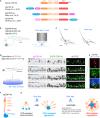Illuminating ALS Motor Neurons With Optogenetics in Zebrafish
- PMID: 33816488
- PMCID: PMC8012537
- DOI: 10.3389/fcell.2021.640414
Illuminating ALS Motor Neurons With Optogenetics in Zebrafish
Abstract
Amyotrophic lateral sclerosis (ALS) is a fatal neurological disorder characterized by progressive degeneration of motor neurons in the brain and spinal cord. Spinal motor neurons align along the spinal cord length within the vertebral column, and extend long axons to connect with skeletal muscles covering the body surface. Due to this anatomy, spinal motor neurons are among the most difficult cells to observe in vivo. Larval zebrafish have transparent bodies that allow non-invasive visualization of whole cells of single spinal motor neurons, from somas to the neuromuscular synapses. This unique feature, combined with its amenability to genome editing, pharmacology, and optogenetics, enables functional analyses of ALS-associated proteins in the spinal motor neurons in vivo with subcellular resolution. Here, we review the zebrafish skeletal neuromuscular system and the optical methods used to study it. We then introduce a recently developed optogenetic zebrafish ALS model that uses light illumination to control oligomerization, phase transition and aggregation of the ALS-associated DNA/RNA-binding protein called TDP-43. Finally, we will discuss how this disease-in-a-fish ALS model can help solve key questions about ALS pathogenesis and lead to new ALS therapeutics.
Keywords: RNA metabolism; neurodegenarative disease; optogenetics; phase transition; protein aggregation.
Copyright © 2021 Asakawa, Handa and Kawakami.
Conflict of interest statement
The authors declare that the research was conducted in the absence of any commercial or financial relationships that could be construed as a potential conflict of interest.
Figures


Similar articles
-
Optogenetic Phase Transition of TDP-43 in Spinal Motor Neurons of Zebrafish Larvae.J Vis Exp. 2022 Feb 25;(180). doi: 10.3791/62932. J Vis Exp. 2022. PMID: 35285826
-
[Optogenetic interrogation of TDP-43 cytotoxicity in a zebrafish ALS model].Nihon Yakurigaku Zasshi. 2023;158(1):16-20. doi: 10.1254/fpj.22085. Nihon Yakurigaku Zasshi. 2023. PMID: 36596480 Review. Japanese.
-
Optogenetic modulation of TDP-43 oligomerization accelerates ALS-related pathologies in the spinal motor neurons.Nat Commun. 2020 Feb 21;11(1):1004. doi: 10.1038/s41467-020-14815-x. Nat Commun. 2020. PMID: 32081878 Free PMC article.
-
In Vivo Optogenetic Phase Transition of an Intrinsically Disordered Protein.Methods Mol Biol. 2024;2707:257-264. doi: 10.1007/978-1-0716-3401-1_17. Methods Mol Biol. 2024. PMID: 37668918
-
The molecular link between inefficient GluA2 Q/R site-RNA editing and TDP-43 pathology in motor neurons of sporadic amyotrophic lateral sclerosis patients.Brain Res. 2014 Oct 10;1584:28-38. doi: 10.1016/j.brainres.2013.12.011. Epub 2013 Dec 16. Brain Res. 2014. PMID: 24355598 Review.
Cited by
-
Emerging Roles of RNA-Binding Proteins in Neurodevelopment.J Dev Biol. 2022 Jun 10;10(2):23. doi: 10.3390/jdb10020023. J Dev Biol. 2022. PMID: 35735914 Free PMC article. Review.
-
Zebrafish as a model organism for neurodegenerative disease.Front Mol Neurosci. 2022 Oct 13;15:940484. doi: 10.3389/fnmol.2022.940484. eCollection 2022. Front Mol Neurosci. 2022. PMID: 36311026 Free PMC article. Review.
-
Zebrafish larva interface: an accessible, modular platform for Danio rerio experiments.Front Neurosci. 2025 Jun 30;19:1593930. doi: 10.3389/fnins.2025.1593930. eCollection 2025. Front Neurosci. 2025. PMID: 40661845 Free PMC article.
-
The Roles of Optogenetics and Technology in Neurobiology: A Review.Front Aging Neurosci. 2022 Apr 19;14:867863. doi: 10.3389/fnagi.2022.867863. eCollection 2022. Front Aging Neurosci. 2022. PMID: 35517048 Free PMC article. Review.
-
A fresh look at mycobacterial pathogenicity with the zebrafish host model.Mol Microbiol. 2022 Mar;117(3):661-669. doi: 10.1111/mmi.14838. Epub 2021 Nov 7. Mol Microbiol. 2022. PMID: 34714579 Free PMC article. Review.
References
-
- Arai T., Hasegawa M., Akiyama H., Ikeda K., Nonaka T., Mori H., et al. (2006). TDP-43 is a component of ubiquitin-positive tau-negative inclusions in frontotemporal lobar degeneration and amyotrophic lateral sclerosis. Biochem. Biophys. Res. Commun. 351 602–611. 10.1016/j.bbrc.2006.10.093 - DOI - PubMed
-
- Arnold E. S., Ling S. C., Huelga S. C., Lagier-Tourenne C., Polymenidou M., Ditsworth D., et al. (2013). ALS-linked TDP-43 mutations produce aberrant RNA splicing and adult-onset motor neuron disease without aggregation or loss of nuclear TDP-43. Proc. Natl. Acad. Sci. U S A. 110 E736–E745. 10.1073/pnas.1222809110 - DOI - PMC - PubMed
Publication types
LinkOut - more resources
Full Text Sources
Other Literature Sources
Research Materials
Miscellaneous

